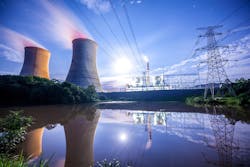In any system that requires cooling, from power generation to chemical processing applications, measuring and monitoring the flow of cooling water, as well as the temperature, is important because changes in either will impact an established process.
In most instances, cooling water will be water from municipal or natural sources, making a magnetic flow meter ideal for measuring and monitoring the flow rates. Impurities and chemical treatment in these water sources allow the water to be conductive, enabling the magnetic flow meter to make a measurement. Additional filtration may be required when using a natural source of water such as a holding pond, river or stream, as water from these sources may include impurities such as sand, dirt or organic materials that can impact the accuracy of the flow measurement and the efficiency and performance of the heat exchanger.
Measurements of cooling water are generally considered non-critical, but they can have a significant impact on the efficiency of a heat exchanger, which can result in poor process temperature control, potentially resulting in quality or yield issues. The ability to accurately measure water usage and flow rates becomes an important part of process temperature control. As we’ll show in this article, there are a number of instances where cooling water provides an essential service to a process.
Heat Exchangers in Power Plants
Heat exchangers are used in hydrocarbon and nuclear power plants, gas turbines, heating and air conditioning, as well as refrigeration and the chemical industry. They have a long history of being used to control process temperatures by using a cooling fluid to transfer thermal energy to a second fluid, thereby heating the first fluid and cooling the second fluid. The flow rates at which the two fluids move through the heat exchanger determine the amount of heat transferred, enabling increased control over process temperatures.
Most power plants will have some type of heat exchanger set up to ensure a safe operation and prevent potentially dangerous temperature excursions. While there are many different designs for heat exchangers, they all provide the same purpose, and one thing that is consistent — they all need a source of water to act as the cooling fluid.
Heat can be transferred through a wall of an inner tube — the heating surface — to a cold fluid. A heat exchanger can also be set up to operate in a counterflow, whereby two fluids flow in parallel but opposite directions. In contrast, a concentric tube heat exchanger can be built in several ways, for example as a coil or in straight sections placed next to each other and connected in a series.
The most used type of heat exchanger is the shell-and-tube design, which uses a bundle of tubes through which the hot fluid flows. The tubes, in turn, are enclosed in a shell designed to let the cool fluid flow through the spaces between the tubes. In nuclear reactors, fuel rods will replace the tube bundle, and the cooling fluid flowing around the rods removes the heat generated by the fission process.
In the case of power plants, the hot fluid is often from combustion exhaust gases that, rather than being vented directly out into the environment, are cooled first before going through a scrubber process and then vented. One additional benefit is that the captured heat is then returned to the process and reused in the plant.
Especially when considering processes such as those at nuclear power plants, it becomes clear that controlling temperature is a critical function for safe operations. Measuring correct water flow into and out of a heat exchanger helps ensure a smooth process. It should be noted that if water moves through too fast, it can damage items inside a heat exchanger. Similarly, if water moves too slowly, it can stagnate and, if there are too many impurities in the water, the heating of the water can cause it to deposit minerals, resulting in corrosion or flow challenges.
Process Temperature Control
Efficiently controlling the temperature of a power generating process is not the only place where a heat exchanger can be critical. In many chemical processes maintaining a correct temperature ensures a consistent end product. In chemical processes, there is often a blending stage involved in creating a product, but to be able to blend material correctly and thoroughly, a process engineer needs to consider the temperature of each ingredient as well as the corresponding viscosity, which changes based on temperature. Leveraging heat exchangers gives the process engineer control over the various reagent temperatures, enabling greater control over reaction times, which ultimately will affect process yield and product quality.
Environmental Regulations When Using Natural Sources of Water
Often natural sources of water are used as sources of the cooling water. In these cases, there are typically environmental regulations related to how much water can be taken from the natural source (rivers, lakes, streams or even drilled wells) and that water must be accurately measured and accounted for. Another concern is the return of the water back to the environment once it’s been used to cool the process fluids. Environmental regulations will often require reporting of the amount of water removed and/or discharged to ensure that the power plant is operating within its allocated limits and is not discharging hot water back into the natural source, thereby disrupting the environment. Selecting a flow meter that can measure accurately and provide a means of verifying meter performance can greatly simplify the compliance and reporting process.
Magnetic Flow Meters Make the Cooling Process Simpler
Though at first glance, cooling water measurement may not seem to be an essential measurement to operations, when delving into the value of cooling and temperature control, it becomes clear that it’s certainly not an afterthought.
Today, magnetic flow meters can efficiently provide important measurement data of water going in and flowing out of a cooling system. An operator can view the cooling water flow rates and adjust control valves as needed to achieve and maintain the desired thermal transfer from the process fluid, enabling accurate temperature control. Efficiently keeping track of water flow reduces not only the expense for water but also other utility costs related to the process that are impacted by temperature.
Magnetic flow meters are obstructionless and low maintenance, with no moving parts to wear out. The right lining material can also reduce the likelihood of deposits attaching to the inside of the meter. Advanced diagnostic capabilities of magnetic flow meters can also verify meter performance, thereby helping to comply with environmental regulations and simplifying reporting requirements. Additionally, with wireless capabilities available today to provide enhanced means for data collection and wireless transmission of flow and diagnostic information, a magnetic flow meter makes an easy addition to the process that requires a record of liquid flow in and out of the process.
With the right tools in place, building and calibrating a robust cooling water setup ensures a smooth and efficient process without major fluctuations that could impact process efficiency, yields, and, ultimately, product quality. WT
About the Author: Trever Ball is director of product marketing for Emerson’s Rosemount Magnetic Flow Meter products. He has 20 years of experience with process instrumentation, specializing in magnetic flow meters.




